‘The United Nations Educational, Scientific and Cultural Organization (UNESCO) is a specialized agency offered by the United Nations with the aim of promoting World peace and security through international cooperation in education, arts, sciences and culture.
UNESCO has declared World Heritage Sites throughout the world to promote their importance and for their outstanding value to humanity while preserving the cultural and historical heritage of different civilizations simultaneously.
India has always been a land of diverse culture and heritage and this beauty has not gone unnoticed by UNESCO which has recognized and celebrated its uniqueness.
Join me in this educational journey where I will tell you about 11 incredible World Heritage Sites in India.
These heritages are recognized by UNESCO itself. With some dates, some facts, and a lot more fun we begin.
#1. Agra Fort
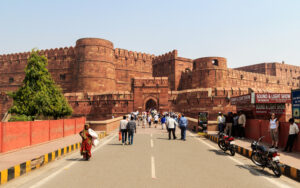
This gem is located in Agra, the land of the ‘Shahenshao ke Shahenshah’ and a cultural center of India since medieval times. Popularly known as ‘Lal Qila’ due to its characteristic color red, the Agra Fort served as the capital residence of the Mughal dynasty during the rule of Emperor Akbar. Originally built by him in the year 1573, it almost took 4000 workers and 8 years to finally complete!
It was accepted as a UNESCO World Heritage Site in the year 1983. The building of the fort is contemporary to the Humayun’s Tomb in Delhi and is popularly known as the ‘walled city.’
The fort was originally a brick-built one but Akbar decided to bring out its utmost glory with the use of the red sandstone. Situated on the bank of river Yamuna, the fort also shares land with one of the 7 Wonders of the World, the ‘Taj Mahal.’
The fort walls share a crescent shape are 70 feet tall and are surrounded by moats. The two gates present are the Amar Singh gate and the Delhi gate. The fort does not hold its complete originality as it went through changes during the reigns of Jahangir and Shahjahan.
A city within a city, it is a very Indo-Persian style of architecture, something whose beauty might leave you awe-struck. The fort will take you back in times of the Mughal Durbars, helping you breathe the comfort and royalty of the time. An absolute beauty!
#2. Sun temple, Konark
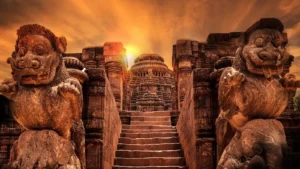
A Temple dedicated to the Hindu God of the Sun, Surya, Konark temple is famously known for its intricate carvings and delicate designs showcasing various images, from worshipping to royalties, royal hunts, military forces, and even erotic carvings. According to the ancient scriptures, the temple is believed to have been built in the 13th century by the Narasingha I of the Ganga Dynasty of the eastern Ghats on his victory.
This UNESCO World Heritage site is actually designed in the shape of the sun’s chariot! Fascinating right? The walls of the temple consist of the wheels of the chariot with the sculptures of 7 seven horses (according to Hindu mythology, 7 horses pull the chariot of the Surya).
Although somewhat ruined, the walls still hold the beauty and essence of the culture. A sundial which is also said to have inspired the wristwatch dial is delicately carved on the temple. The monument is a fine example of the Orrisa style of architecture and is one of the most famous architecture in India. The Chakra of the Konark temple is featured in the new 10rs Indian note.
#3. Group of monuments in Mahabalipuram
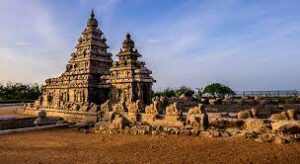
‘A group of sanctuaries’ as UNESCO quotes, these group of temples were built by the famous Pallavas on the Coromandel coast in the 7th and 8th Century. Its main center of attraction is the set of 5 rathas (temples in the form of chariots) which are believed to be a part of the Mahabharata. The 5 rathas are each dedicated to the 5 Pandavas. The site has almost 40 ancient monuments and Hindu temples and are can be easily spotted by the name of ‘Seven Pagodas’ in many colonial publications. ‘The monuments are a fusion of religion, culture, and legend relating to the Hindu religious pantheon’ (Wikipedia).
The best-known rock structure is definitely the Ratha temples, the 5 rathas of the Pandavas, however, these temples are not dedicated to the Pandavas but are rather dedicated to the deities such as Shiva, Shakti, and Vishnu. The inscriptions on the walls of the monuments give an insight into medieval South Indian history and culture. The language spoken was most probably Sanskrit (inscriptions on the wall).
#4. Keoladeo National Park
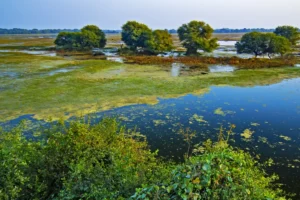
The Keoladeo National Park also known as the Bharatpur Bird Sanctuary is a breathtakingly beautiful destination in Rajasthan. The park allows you to stay closer to nature and breathe in its air while enjoying the scenery of various species of Flora and birds. The sanctuary acts as a site for reserve, a residence to thousands of native and many migratory birds especially during the winter days. The sanctuary in the earlier times served as a royal hunting reserve during the 1800s and was a hunting reserve for the Maharajas and the British. According to some popular stories, Lord Linlithgow, the Viceroy of India (1936-1943) killed more than 1000 ducks along with his partners in a single day. However, after the independence of India, the newly formed government took it under itself and declared it as a bird sanctuary on 13th March 1973.
The Keoladeo National Park was also declared as a UNESCO World Heritage Site in 1985. The sanctuary is now home to almost 400 avian species! The most iconic of all is the Siberian Crane. The Keoladeo National Park is also a mosaic of seasonal wetlands, tropics, swamps, and woodlands making it a suitable living zone for different species of both flora and fauna.
#5. Moidams, the burials of the Ahom Dynasty
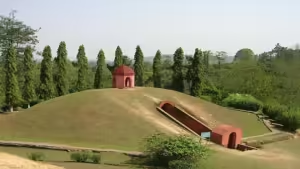
While you were drooling over the Egyptian pyramids, we found out that India has its own pyramids. Shocking right? Situated in the valleys of the Patkai Ranges in Eastern Assam are the moidams/maidam. Derived from the Tai-Ahom word Phrang-Mai-Dam, where Phrang-Mai means ‘to bury’ and Dam means ‘the dead.’ These royal burial sites are elevated or rather like a dome-shaped structure on the land which consists of one or more chambers in the vault. The Royalties of the Ahom’s were rather buried in the chambers. The hemispherical elevated land has an open pavilion called the chow chali.
The moidams of the Charaideo are recognized by UNESCO as a World Heritage site. Along with the body of the dead, the chambers consisted of various necessities for the afterlife and other servants, caretakers, and even animals like elephants and horses! You will be amazed to know that at least 10 people were buried alive along with the deceived to serve him/her in the afterlife. The site of these moidams is worth watching to relive a lost tradition/custom yet again.
#6. Group of monuments, Pattadakal

A victory monument, Pattadakal, was erected in the era of the Chalukya Kings (7th–8th century). Built by the prestigious, Rani Lokamahadevi to commemorate the victory of her husband over the kings of the South. Situated in the lap of the Northern regions in Karnataka, this UNESCO World Heritage site is a complex of Jain and Hindu temples of ‘eclectic art,’ as UNESCO quotes.
The beauty of these temples showcases a harmonious blend of Nagara and Dravidian styles, reflecting the region’s rich culture. The beauty of the craftsmanship and skills can be predicted from the rich, intricate sculptures and carvings presenting delicate dance forms and mythological stories.
The use of sandstone makes the monument glow like gold when the rays of sunlight fall upon it. Its serene green surroundings add up to its beauty. This group of ancient temples acts as a bridge between history and historians, helping them understand the Chalukya Dynasty better. Come live this extraordinary experience of the Dravidian-style architecture.
#7. Valley of Flowers

Located in the lap of the Himalayas is the ‘Valley of Flowers.’ The valley famously known for its exquisite flora and fauna falls in the trek path to Shri Gurudwara Hemkund Sahib. The valley during its peak season becomes a full bloom one resembling a kaleidoscope of colors with flowers blooming of pink, blue, red, yellow, and many other colors.
This Indian national park located in Chamoli was established in the year 1982 and was declared a UNESCO World Heritage Site in 2002. Imagine a serene surrounding filled with perfumed wildflowers as you lie down on the grass-covered ground with a mild breeze flowing as you watch the most beautiful sunsets! Calming right? This is what the valley of flowers is.
However, it’s not only about the floral beauty but also the trek that fills up one’s heart with thrill and excitement. A journey through a green lushy forest up on the hills with a cool stream flowing across.
It is absolutely a dynamic landscape with flower blooms in the summer and snow-covered peaks in the winter, this place is an absolute marvel of nature!
#8. Bhimbetka
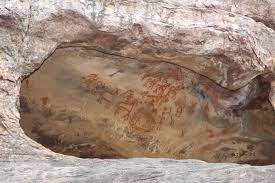
The rock shelters of Bhimbetka are one of the famous UNESCO World Heritage Sites in India. Spread over 7 hills with over 750 rocks spread around, this historical landmark plays a significant area of study for historians and general history lovers for understanding the Paleolithic and Mesolithic periods. Located in the Raisen district of the Madhya Pradesh region, some of these caves are believed to have been inhabited more than 100,000 years ago.
The Bhimbetka rock shelters are home to prehistoric cave paintings and the earliest are dated back almost to 100,000 BCE! The cave paintings are based on various themes such as dance, hunting, agriculture, and even festivals and gatherings.
The site contains the world’s oldest stone walls and floors and is home to the oldest paintings in India.
The art provides an insight into the lives of early humans and their interaction with nature and wildlife.
#9. Champaner-Pavagadh Archeological Park
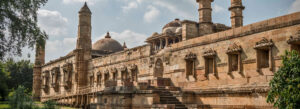
The Champaner-Pavagadh Archeological Park is a UNESCO World Heritage Site located in the Panchmahal district of the Gujrat state in India. The city of Champaner was founded by Vanraj Chavda, the most excelled king of the Chavda Dynasty in the 8th century.
The park consists of archeological and cultural monuments, and forts spreading from the hills of the Pavagadh to the city of Champaner. The intrusion of the Muslim culture is fairly evident depicting the transition from the Hindu to the Islamic inspired architectures. The UNESCO accepted it as a World Heritage Monument in the year 2004.
There are 114 monuments of 11 different types in this Gujrat-based archeological park. Only 39 of these monuments are maintained under the ASI, including the Jami Masjid, Kevda Masjid, Sheher ki Masjid, Lakulisa Temple, Mahakali Mata Temple, Jain temples and some Tombs and Mausoleums as well. A beautiful place to visit in September, this place offers you a great insight into the architecture of both the Indian and Islamic structures. A trip to Gujrat will be incomplete without this!
#10. Jantar Mantar, Jaipur
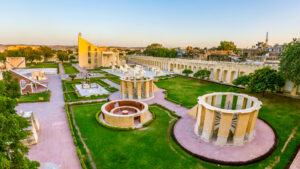
The Jantar Mantar in Jaipur was built by the Rajput King Sawai Jai Singh, the founder of the ‘Pink City,’ Jaipur. The complex of the Jantar Mantar consists of 19 astronomical instruments including the world’s largest stone sundial which has bagged its title of UNESCO World Heritage Site.
The Jantar derives from the Sanskrit word ‘Yantra’ which means instrument and Mantar from ‘Mantrana’ which means ‘to calculate.’ This fascinating observatory is situated in the heart of the city near the famous ‘Hawa Mahal.’ However, to our wonder, the Jantar Mantar is not limited to Jaipur only! Maharaj Jai Singh constructed such observatories in other parts of India including Mathura, Delhi, Ujjain, and Varanasi as well.
The King collaborated with Emperor Muhammad Shah to rectify astronomical calculations in Islamic Zij. The King went further to gather data from European and Persian nations to gain accuracy in these tables. The instruments were constructed around 1728-34 based on these observations.
Check out: Raja Jai Singh and his zij | Raja Jai Singh and his zij )
#11. Nalanda Mahavihara
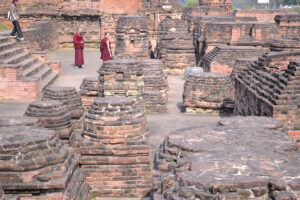
You must be aware of some of the most ancient universities of the World including the University of al-Qarawiyyin, Taxila University, etc., however, did you know that the Nalanda Mahavihara in Bihar was a renowned center of learning in the 3rd century BCE and was the first residential university in the World! the university served as a center of learning and research for at least 700 years (3rd BCE-13th CE).
At its peak, Nalanda attracted students from all over the world including China, Japan, Tibet, Sri Lanka, etc., and offered specialization in philosophy, astronomy, logic, Buddhist Studies, and even medicine. This ancient university in India was also home to one of the world’s largest libraries with a collection of about 9 million books, serving as a center for preserving and propagating Buddhist teachings.
The present remains of the university consist of Stupas, shrines, viharas (residential and buildings), and important artworks in stucco, stone, and metal. UNESCO declared it a World Heritage Site in 2016, making it one of the most important historical sites to read about the history of Education and its propagation.
CONCLUSION
UNESCO’s recognition of these iconic monuments has not only highlighted their cultural and historical value but also has helped India touch the sky of glory and global fame by showcasing its cultural richness. The title of ‘World Heritage Site’ is not a small one and neither are the glory of these monuments!
Checkout this blog for more monuments to explore 20 Historical Monuments of Sri Lanka: A Journey Through Timeless Treasures

